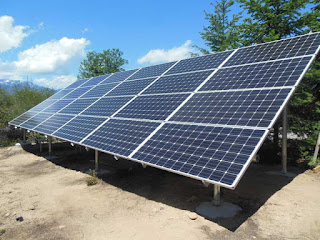As power bills continue to rise in households, more and more
homeowners are thinking about converting their homes to solar energy. As a
matter of fact, in some parts of the United States, residents are paying
between $400 and $900 per month for their utility bill. That is a lot of money!
So if you are considering solar, what do you need to get started?
The solar panels themselves are perhaps the most well-known
of all the system components, since they're the most visible part of the
package, often perched atop homes and businesses roofs. Solar panels are also
considered the life blood of a solar power system, because solar panels
actually capture the sun's radiation, thereby initiating the entire process of
converting sunlight into an electrical current. The job of solar panels is to
essentially create the electrical current.
Solar power systems would be worthless without solar inverters.
The way they work is, once radiant sunlight is converted into electricity,
solar inverters transform the electrical current from direct current (DC) power
to alternating current (AC), so it can actually be used in various
applications. Since the U.S. grid system actually works on AC power, solar
inverters have the ability to convert electrical converts back and forth
between DC power (used to power devices in the home) and AC power (to put
electricity back onto the grid).
Next, a series of cabling infrastructure is necessary to
bring the converted power into homes and business. In essence, the solar cable
is a wire that interconnects all parts of the solar PV system. Cabling networks
can vary, but typically are designed to be UV and weather resistant and capable
of dealing with extreme fluctuations in temperature (both heat and cold), since
one common factor for these systems is that they're used outdoors.
Finally, the mounting system is the skeleton of the solar
power system. Mounting systems are the platforms upon which solar arrays
reside. Most commonly, home and business owners mount their solar systems on
top of their roofs so that they can gain greater access to direct sunlight.
However, mounting systems can also be built on the ground or on other erected
structures, like a galvanized steel pipe frame.
Depending on the location of your home and building codes, putting
your solar panels on the ground using the steel pipe is a good choice for the
long-term investor. The pipe will not rust, and it will not rot like a wooden
structure would. It will also not require being bolted into the roof, which could eventually cause damage to your roofing material and subroof.
At Ohio Galvanized Tube, we have been supporting these green
applications – and more – by producing top quality steel pipes and tubing for
over 20 years. We proudly manufacture the GATORSHIELD® A500
mechanical steel tube, which is great for outdoor uses like solar power cell framing and more. When you want a company that supports green efforts with the
highest quality steel tubing available on the market, contact us today.


Comments
Post a Comment